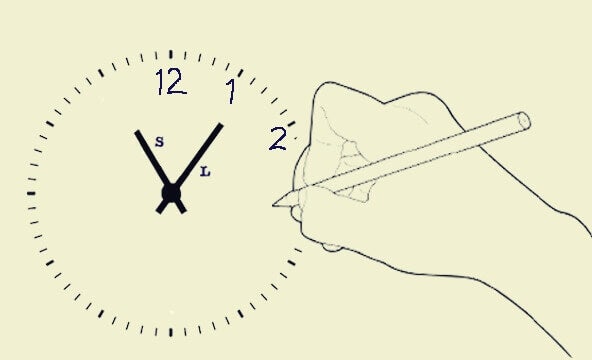The clock design test is a very simple diagnostic test to apply, whose objective is to evaluate the cognitive alterations of patients and to be able to diagnose possible neurological and psychiatric disorders, and since its first application in 1953, it has generally been one of the most common. tests to identify Alzheimer’s disease and other diseases first.
When we learn that this test was based on asking a person to design a watch whose hands read 11h 10min, there is a tendency to doubt the validity and effectiveness of the diagnosis, however, there are some practical aspects that we must consider in relation to what which requires this (apparently) simple task.
- Draw a clock.
- It’s so simple that it seems amazing that this is one of the most forceful tests when it comes to detecting cognitive disorders like Parkinson’s or Alzheimer’s.
First, we need to understand what is being asked: “design a clock that marks that time”. The person must then plan, pay attention to motor performance, adjust their visual perception, visomotor coordination and visual-constructive ability. It’s not just any task. The cognitive efficiency of the watch test makes it one of the most useful tests, especially when compared to other more complex, expensive and less reliable tests.
This test was first developed and applied in 1953, with the aim of analyzing constructive apraxia (common in dementia) and also identifying the extent of lesions in the parietal cortex; gradually, realizing the effectiveness of the test, it became an essential tool for diagnosing associated cognitive decline primarily in the early stages of Alzheimer’s disease.
The application of this test, as we have already said, is simple, however, it must be guided and analyzed by a qualified psychologist, because from the watch design test it is possible to identify various disorders, deficits or brain damage. that there are up to 15 different ways to evaluate this test.
In general, your doctor may choose to apply the test in two ways
It is very common to wonder why the clock should dial exactly 11h 10min. Something as simple as this involves the participation of the 2 visual hemicampos. It also requires the person to obey the instructions, understand them, remember what the clocks are like, how they are allocated every hour, and properly plan where to place each hand.
As we have already said, there are many ways to analyze this test: the sphere, you usually see the order in which the numbers are placed, the orientation, either inside or outside the sphere, if they are only on one side or if there is excessive numbering In the case of patients with schizophrenic disorders, for example, an almost millimeter obsession usually seems to define every minute in the sphere , making the drawing a strange, fuzzy and almost unintelligible composition.
Maria is 80 years old and first attended, with her children, an appointment with a psychologist. “I forget things, ” he said with laughter, as his family nodded anxiously. The professional, after collecting some data and engaging in a conversation with Mary, to reassure her and get to know her better, asks her to design a clock to set a specific time, 11:10min. The result is what we see below.
Mary’s cognitive decline is obvious. This test will not be the only one that will be performed with this patient, the diagnosis of Alzheimer’s will be confirmed (or not) by other psychological strategies, however, the clock design test is a starting point and offers reliable and revealing information.
Maria is old and loss of cognitive abilities is common. At the same time, it should be mentioned that in recent years this test has been increasingly being perfected. Is there even a pen designed by the Massachusetts Artificial intelligence and computer science laboratory (MIT)?recording a person’s pulse, accuracy, interruptions, tremors, and other irregularities.
Thanks to this technology, it is possible to obtain several parameters. Most interestingly, however, it can indicate very early diagnoses of Alzheimer’s disease or Parkinson’s disease. Early identification would give us the opportunity to develop better strategies, apply appropriate treatments to provide comprehensive patient care, and a better quality of life to slow the development of the disease. Therefore, the watch design test will remain one of the best tools to identify this type of disease.

